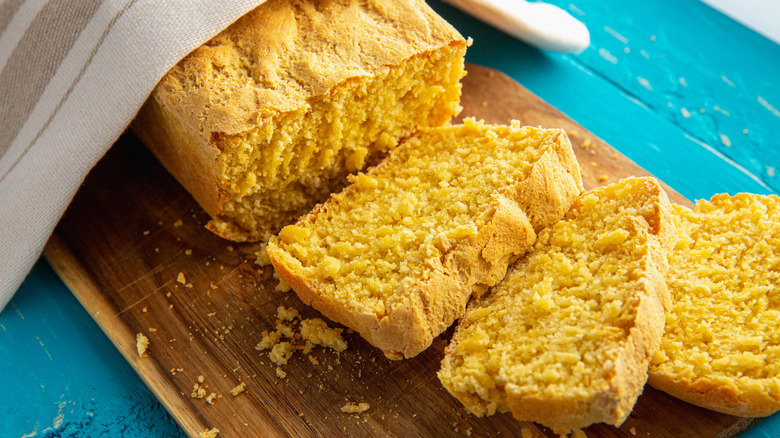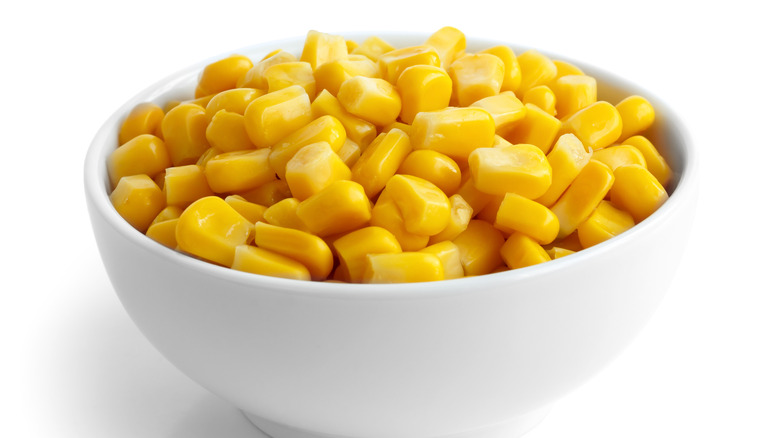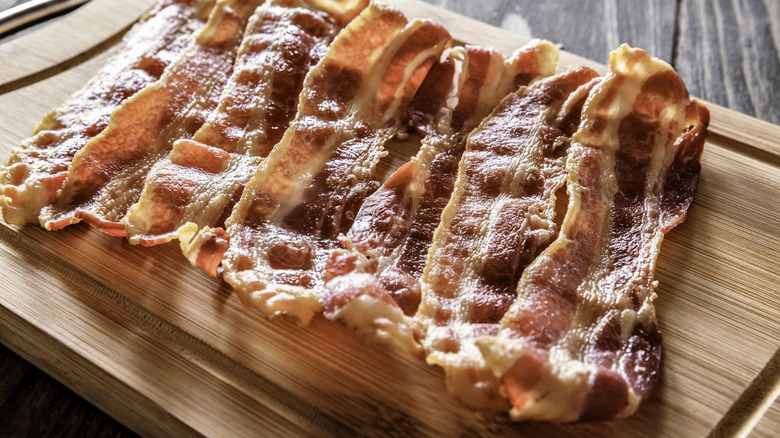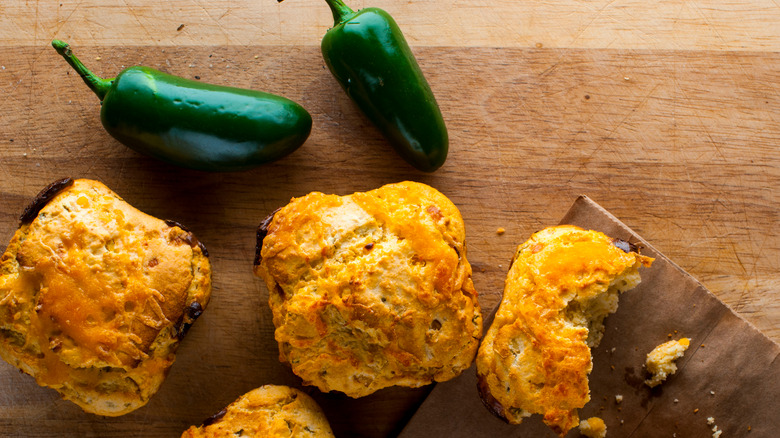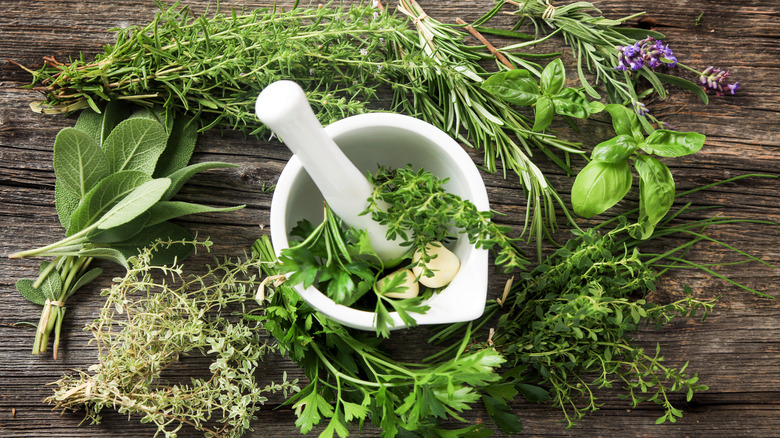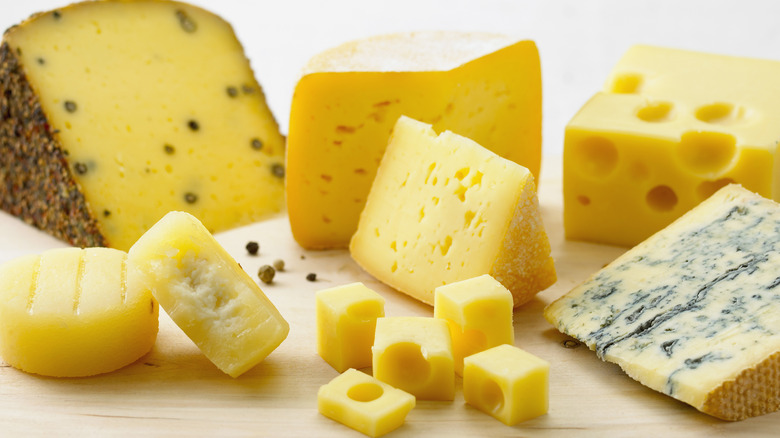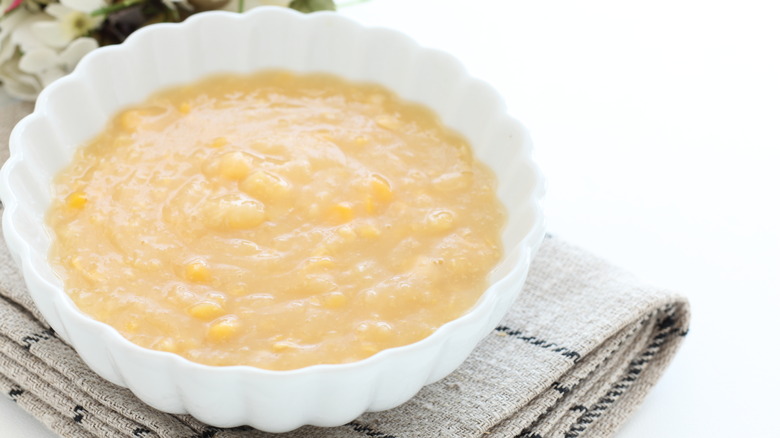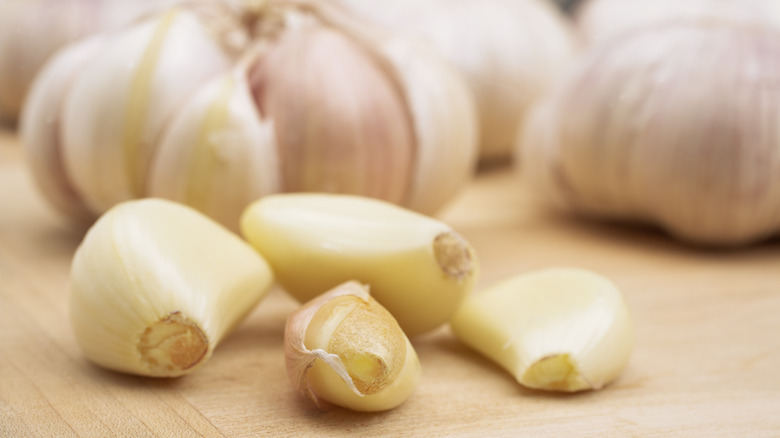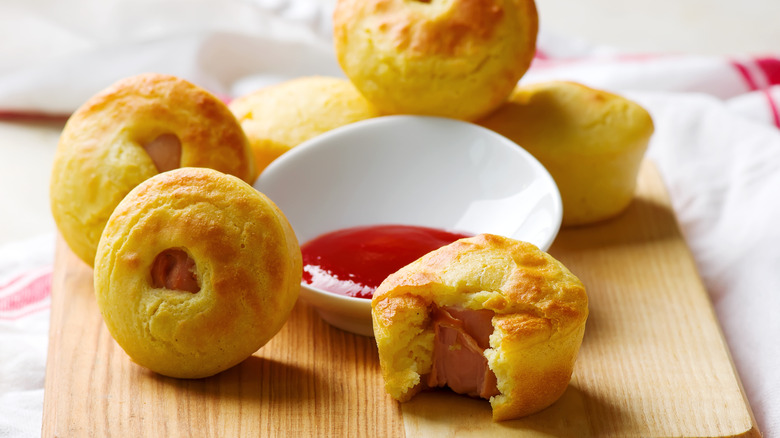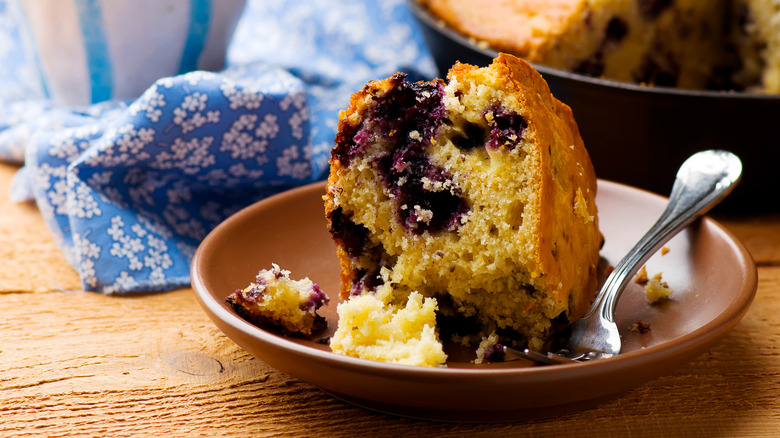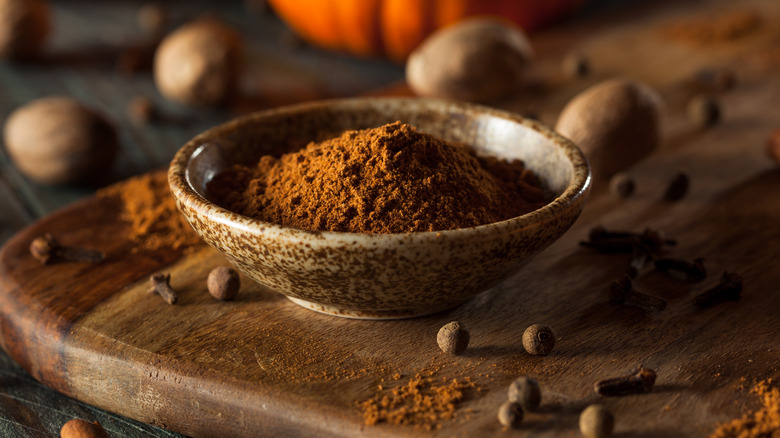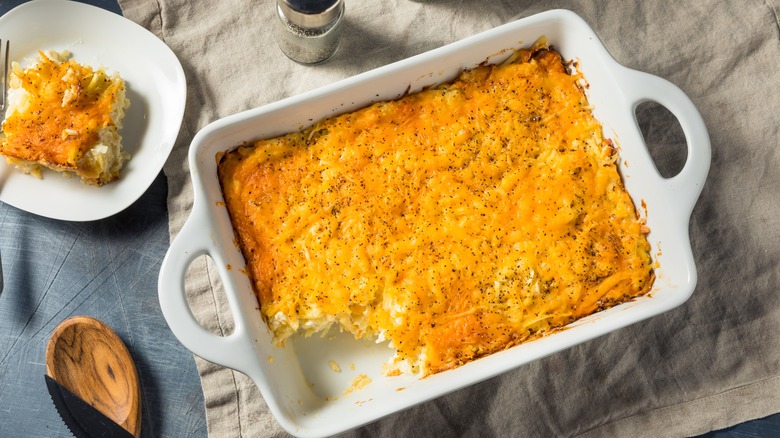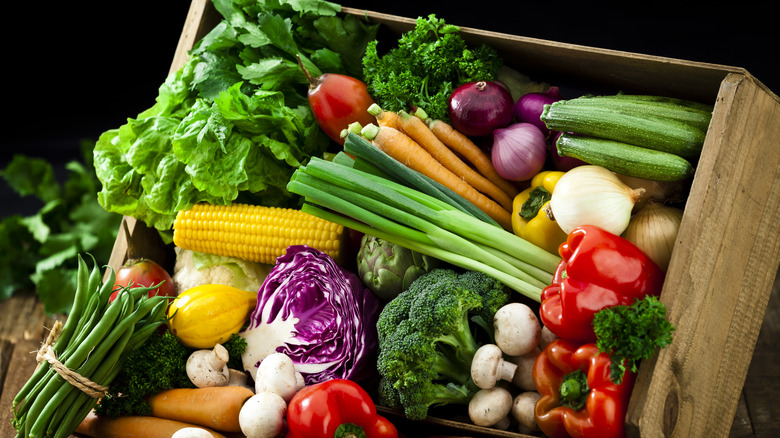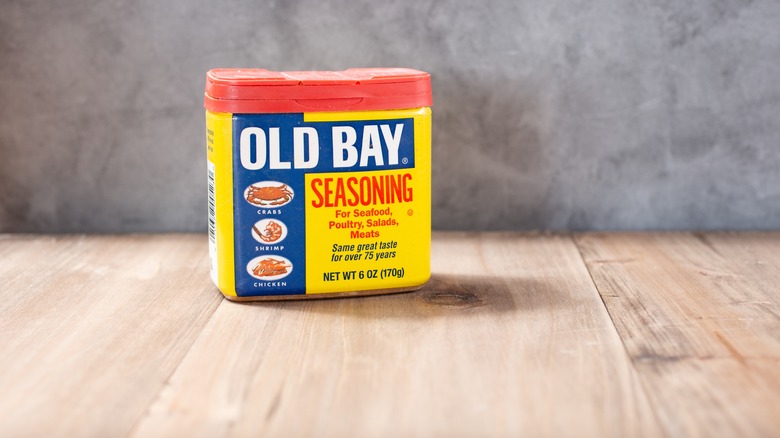13 Ingredient Mix-Ins That Will Elevate Your Cornbread
If ever there were a side dish for all seasons, cornbread would be it. Light yet hearty, a square of classic cornbread fits as easily beside a light summer salad as it does a Thanksgiving turkey.
Cornbread is a quintessentially American culinary creation with deep roots. Similar to how other American traditions have evolved over time, each culture that has survived off its grainy goodness left behind a unique cornbread legacy — so much so that there are over 1,800 words and phrases that describe a baked cake made of cornmeal, according to American Speech.
Due to this longevity, there are dozens of variations on the "traditional" cornbread recipe, and it all depends on who you ask. Native Americans spearheaded the process of grinding dried corn into meal and mixing it with animal fat, water, and salt before cooking over an open flame or boiling, ostensibly inventing cornbread. Later, European settlers and enslaved peoples adopted the same process, adding their own touches to the recipe as it was passed down through the generations.
Today, most of us enjoy the ease of store-bought cornbread mix, even if it can easily succumb to a dry, crumbly fate. With some creative cooking, you can elevate your next batch of cornbread (yes, even the boxed kind) to tasty new heights.
Sweet corn kernels
The easiest way to elevate store-bought cornbread? Add more of the real thing. Tender and sweet with just the right amount of chew, bona fide corn kernels should become a staple in your cornbread repertoire.
When sweet corn is in season, you can't beat freshly grilled or roasted kernels chopped right off the cob. If you don't fancy watching corn kernels fly all over your kitchen, using canned or frozen corn will taste just as good with minimal effort. Start by adding roughly half a cup to your cornbread batter — if you're going all in, a full cup will bring even more texture.
If you're not sold on the bite of a whole kernel, try chopping the corn in the food processor to achieve smaller bits, or simply blitz until the mixture reaches a purée consistency. Either way, your final product will thank you for the extra moisture and boost of flavor.
When it comes to adding corn, those watching their blood sugar levels can rest easy. While sweet corn does contain more sugar than other varieties, it is a fairly low-glycemic food, meaning it won't cause your blood sugar to spike significantly, according to Healthline. Among corn's other health benefits? It's rich in folic acid (a nutrient of note for pregnant people) and lutein, which helps protect your eyes from that damaging blue light radiating from your phone and laptop screens.
Bacon
Animal fat is a classic cornbread ingredient, used in Indigenous peoples' recipes long before European colonists showed up. The tradition carries on in Appalachia, where locals and living legends alike continue to add bacon grease to their cornbread. But if you're going to add the grease, you may as well fold in some pieces of porky goodness too.
Some cornbread recipes can be on the sweet side, especially Northern variations that call for the addition of sugar. To offset cornbread's natural (or not-so-natural) sweetness, try throwing some crispy, crumbled bacon into the mix. The smokiness of the meat gives oft-monotonous cornbread a welcome, savory note that pairs equally well with barbecue and grilled veggies.
If you find yourself with too much bacon grease after frying up your cornbread mix-ins, add a bit to your cast-iron skillet before heating and filling it with batter. Not only will the grease ensure your cornbread comes out in one delicious piece, but it will also provide the signature crisp, golden crust of your comfort-food dreams.
Jalapeño
A simple (and cheap) way to spice up your cornbread is with a classic Tex-Mex trick: add some jalapeño. While the spice-averse may balk, consider the cooling effect of cornbread paired with a pot of chili. The sweet, dense side dish works wonders at soaking up chili's signature spice, and the same can be true with jalapeños if you know how to handle them.
There are a few tricks to effectively cooking with one of America's most popular chiles without blowing away your tastebuds. When shopping for your perfect pepper, look for a smooth, shiny green specimen — the younger the chile, the less spicy it will be. Most grocery store jalapeños are picked before they're ripe and are typically on the milder side. If you are wanting a bit more spice, search for a mature, red pepper to toss into the mix.
Once you've procured your pepper, be sure to remove the seeds. This is where the majority of the jalapeño's heat resides in the form of capsaicin oil. Don't forget to wash your hands thoroughly after handling the hot chile. Another way to mitigate the spice is to soak your sliced jalapeños in salt water for at least 30 minutes before using.
If you're still not sold on spicy cornbread, consider adding some sweet heat in the form of chipotle. These smoked, dried jalapeños tend to be more flavorful than their fresh counterparts, particularly when canned in earthy adobo sauce.
Fresh herbs
Liven up a boxed mix or bland cornbread recipe with a few fresh herbs. In addition to adding brightness to the dish, herbs can transform classic cornbread into the perfect pairing for whatever meal is in season. For a boost of fall flavor, try sprinkling in some fresh sage (sparingly; too much of the herb can come across as soapy) while summer recipes could benefit from a burst of sweet basil or dill.
But what happens if you don't have fresh herbs on hand? Their dried counterparts can be an effective substitute when used thoughtfully. While it might be tempting to just swap in one for the other, it's really not that simple. Dried herbs are highly concentrated and therefore tend to be much more potent than fresh. According to MasterClass, a recipe that calls for fresh herbs only needs one-third the amount of dried herbs to achieve the same flavor, or roughly one teaspoon of dried herbs for each tablespoon of fresh.
To get the most out of those dried herbs, try rubbing them between your fingers to release their essential oils. A quick sautée in olive oil prior to adding them to your cornbread batter will also rehydrate the herbs and help them to release more of their goodness.
When it comes to flavor, there are some substitutions that one must handle with care. Herbs like basil and cilantro are better fresh, while oregano proves much more potent when dried.
Cheese
There are few dishes that aren't improved with the addition of cheese. Even the lactose-intolerant can't argue with its sinfully gooey goodness — just its unfortunate after-effects. When added to often-crumbly cornbread, cheese helps better bind the mixture with additional fat, bringing a delightfully savory element to corn's sweet flavor profile.
Similar to how sour cream or buttermilk are frequently added to Southern cornbread recipes, folding cheese (and therefore fat) into your batter will help keep the cornmeal hydrated, resulting in a moister, more tender final product thanks to that extra milk fat. Not only are you bringing extra flavor to the party, but you're also ensuring that never again will you have to face the embarrassment of serving dry, crumbly cornbread at the family potluck.
Cheddar is a classic cornbread pairing, but consider experimenting with smoky gouda, nutty Emmentaler, spicy pepper jack, or even a dash of tangy goat cheese. The only limit is your imagination — and taste buds.
Creamed corn
Another secret to indulgent, Southern-style cornbread? A good, old-fashioned can of creamed corn. The blend of fat and concentrated corn flavor brings such a perfect balance of moisture, texture, and taste to a box of cornbread mix that even your grandmother might end up asking you for the recipe.
Creamed corn elevates cornbread to the Thanksgiving table in classic corn spoonbread, a historic American dish dating back to the nation's earliest cookbooks, including 1824's "The Virginia Housewife" and 1855's "Carolina Housewife." A delicious combination of French soufflé, Yorkshire pudding, and Southern cornbread, the recipe has evolved over time but generally contains cornmeal, a combination of fats, and a raising agent like baking powder or egg whites served steaming hot straight from the oven with a spoon — hence the dish's distinctive name.
To simplify things (and achieve a flavorful side effect with no extra effort), swap in a can of creamed corn for the dairy in your favorite recipe. The result is a creamy, custardy, corn casserole that will leave your guests begging for seconds.
Garlic
Give your cornbread an Italian flair by adding garlic to the mix. Of course, you can take the easy way out by mincing up some whole cloves and tossing them in your batter, but with a little extra effort, you can transform your cornbread into something truly special.
Subtle and slightly sweet, roasted garlic is one of the most underutilized ingredients in the modern kitchen. Seasoned, roasted, and mashed, whole cloves can be quickly mixed into boxed cornbread for an elevated accompaniment to smoked meats, rich stews, or even a Caesar salad.
If you're nervous about going all in on garlic, try smearing some homemade garlic butter on your next batch of cornbread. This simple condiment requires just three ingredients and a bowl. Take softened butter (leave it out overnight for the best results), add minced garlic, chopped fresh parsley, and mix well. You can whip out your mixer if you really want, but a fork will work perfectly fine. Store the leftovers in the refrigerator in an airtight container to avoid a rogue garlic smell — delicious in the kitchen, not so much in your fridge.
Hot dogs
On the hunt for a kid-approved treat that will feed a crowd? Transform a box of cornbread mix into homemade corndogs. This easily scalable recipe is perfect for summer barbecues, soccer games, or just simple snacking.
Unlike the corndogs at your local county fair, you won't need to whip out a deep-fryer for this one. Simply fill a greased muffin tin with cornbread batter and place roughly a third of a hot dog in the center of each one before baking. The results are tasty, fun, and on the table in about 30 minutes.
The best part about this semi-homemade hack is that it can be easily customized to satisfy more sophisticated palates as well. Swap the hot dogs for chicken sausage in any flavor that suits your mood, stuff the center of the muffins with breakfast meat for an on-the-go morning meal, or keep things veggie-friendly with a plant-based meat alternative or pieces of roasted portobello mushroom.
Fresh fruit
If some folks are already adding sugar to their cornbread or serving it with a drizzle of honey, it stands to reason that other sweet pairings, like fruit, would work just as well. Let the changing seasons be your guide as you experiment with various berries, stone fruits, and citrus zests throughout the year.
For a fresh taste of summer, throw some ripe blueberries into your batter. Not only will the fruit add a touch of sweetness to your cornbread, but the striking color combination of yellow and purple will pop, elevating the dish to brunch status. For even more zing, try tossing in some lemon zest, too. Lemons and blueberries are a classic combo for a reason: The tartness of the zest balances the sweetness of the fresh fruit. The possibilities are endless, especially if you have an abundance of willing taste testers.
No matter which fruit you choose, just be sure to toss it in a small amount of flour before mixing it into the cornbread batter. A light dusting on each piece of fresh fruit will prevent all that juicy goodness from sinking to the bottom of your bread.
Seasonal spices
When the leaves start to turn and pumpkin spice everything hits store shelves, you might just be inspired to spice up your next batch of cornbread, too. With just the right touch, the dish can be elevated from a holiday sidekick to the main attraction.
While you can certainly add a dash of store-bought spice into your batter, consider making your own — fresh pumpkin pie spice is surprisingly easy to make with ingredients you likely already have in your spice cabinet. Simply combine cassia bark (a cinnamon stick can be substituted here, but the flavor will be much more subtle), whole nutmeg, allspice berries, and cloves in a coffee grinder, grind, mix in the ground ginger, and — voila! — homemade pumpkin spice everything.
Go all in on autumnal cornbread by mixing in a can of pumpkin purée along with the pumpkin pie spice. The addition of the purée will create a slightly denser, more cake-like product than a traditional cornbread, but definitely still delicious. Pumpkin spice cornbread might just be the perfect fall treat for those who find a PSL drink far too sweet.
Hash browns
From stuffed French toast to sweet potato pancakes, brunch dishes can just be too darn sweet, especially after a late night out. Take a page out of the Waffle House playbook with this Loaded Cornbread Casserole recipe. Cheese, creamed corn, and sour cream bring the moisture, while bacon bits add a much-needed savory bite. Stir in some hearty hashbrowns for a delightful breakfast twist on the cheesy cornbread casserole.
Double starch may seem like overkill, but if the booze is flowing, you'll be grateful for such a hearty side dish with your scrambled eggs. According to Duke University, eating while consuming alcohol causes the pyloric sphincter (the bit that separates the stomach from the small intestine) to close so that the food can be digested, therefore slowing down the process of alcohol being absorbed into your bloodstream. Fatty foods — like a cheese-and-bacon-loaded cornbread hashbrown casserole — slow down the alcohol absorption process significantly, and consuming starches can help prevent nausea. So, go ahead and help yourself to seconds while you sip your Bloody Mary.
All the veggies
Celebrate cornbread's versatility by using it as an excuse to clean out your vegetable crisper. Throw leftover veggies into your next batch of cornbread to enjoy some added health benefits — like vitamins A and C from bell peppers or potassium and magnesium from spinach — and extra fresh flavor.
This kitchen hack also works wonders when it comes to getting picky eaters to eat their veggies. Chop raw peppers, onions, leafy greens, or whatever you've got on hand extra small, or run briefly through a food processor so that their texture is nearly indistinguishable from that of the cornmeal. Throwing in some cheese or creamed corn helps hide those flavors from even the most avid vegetable-avoiders.
Give veggies a chance with a Zucchini Tomato Chile Cornbread recipe. This carb-loaded side dish is the best of both worlds, serving as the perfect accompaniment to chili, barbecue, or a summer salad and providing you and your crew with an extra serving of vegetables disguised as flavorful cornbread.
Old Bay seasoning
Nothing says summer on the coast quite like a good old-fashioned seafood boil. Whether it's shrimp in the South, crabs in the Chesapeake Bay, or clams in Connecticut, most variations on the party favorite include a healthy dose of Old Bay seasoning. A blend of 18 different spices, the 75-year-old spice mix is a classic for a reason — and a well-kept secret. To this day, no one but the gatekeepers at McCormick knows exactly what's in the savory concoction, although it has been confirmed that paprika, peppers, and celery salt are part of the magic mixture.
Regardless of what species of shellfish is being served, you can be sure to arrive with the perfect seafood boil side dish when you whip up a batch of cornbread elevated with a dash of Old Bay. Even if the shellfish on offer isn't seasoned with the legendary spice mix, Old Bay's classic flavors will pair well with the feast.
You can even use cornbread as a tasty vehicle for all those leftovers. Chop up shrimp, crab, or whatever seafood still remains post-boil and toss it into your cornbread batter with a dash of Old Bay seasoning for a hearty snack cake, or fry tablespoon-sized balls for a tasty play on hushpuppies.
